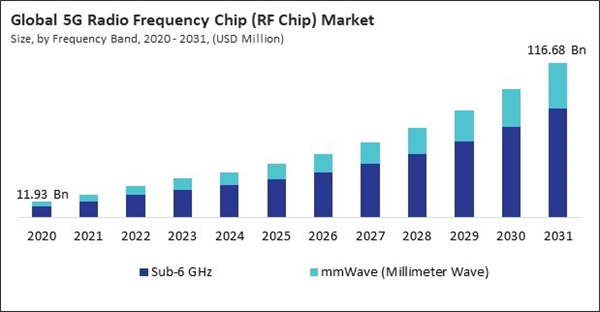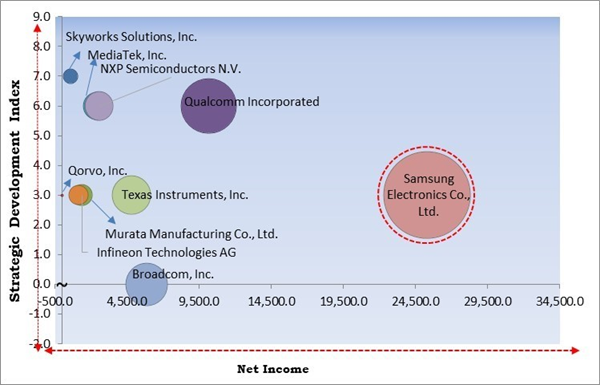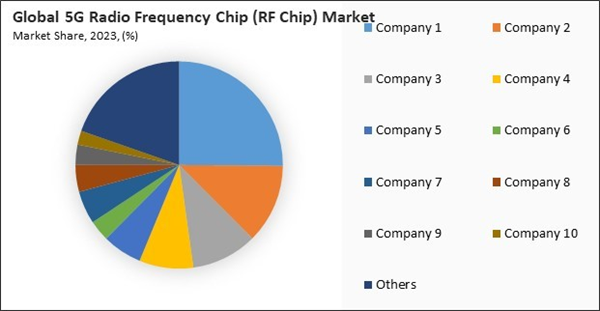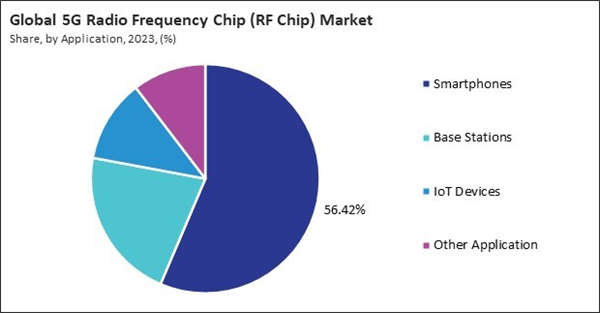The Global 5G Radio Frequency Chip (RF Chip) Market size is expected to reach $116.68 billion by 2031, rising at a market growth of 19.1% CAGR during the forecast period.
The rapid expansion of 5G networks and mobile connectivity in India and China is driving significant growth in the market. As global leaders in telecommunications, both nations are experiencing a surge in 5G base station deployments, rising mobile subscriber bases, and increasing data consumption. These advancements are accelerating the demand for RF chips, essential for signal transmission, network efficiency, and seamless connectivity in 5G devices and infrastructure. Thus, the Asia Pacific segment recorded 36% revenue share in the market in 2023.
The major strategies followed by the market participants are product launches as the key developmental strategy to keep pace with the changing demands of end users. For instance, In June, 2024, Qorvo, Inc. unveiled three RF multi-chip modules (MCMs) for advanced radar applications, enhancing performance and reducing size, noise, and power consumption. These compact modules streamline design and assembly, supporting phased array radar systems. Qorvo’s Anokiwave acquisition strengthens its position in high-performance RF solutions for defense and aerospace. Additionally, In January, 2024, Texas Instruments, Inc. unveiled the AWR2544 77 GHz radar sensor for satellite radar architectures, enhancing ADAS decision-making. It features launch-on-package (LOP) technology, reducing sensor size by 30% and extending range beyond 200m. TI also unveiled software-programmable driver chips for safer battery management and powertrains.
The growing adoption of 5G-capable smartphones and consumer electronics is driving the rapid expansion of 5G technology. Leading smartphone manufacturers like Apple, Samsung, and Xiaomi increasingly integrate 5G RF chips to enhance network performance and cater to evolving consumer demands. Therefore, this trend is expected to sustain the growth of the RF chip industry as 5G penetration continues to expand globally.
The leading players in the market are competing with diverse innovative offerings to remain competitive in the market. The above illustration shows the percentage of revenue shared by some of the leading companies in the market. The leading players of the market are adopting various strategies in order to cater demand coming from the different industries. The key developmental strategies in the market are Product Launches and Product Expansions.
The 5G radio frequency (RF) chip market is highly competitive, driven by increasing demand for high-speed connectivity, low latency, and advanced network capabilities. Market players focus on technological advancements, miniaturization, and power efficiency to enhance chip performance. Competition intensifies with the rise of millimeter-wave (mmWave) and sub-6 GHz technologies, requiring continuous innovation. Growing adoption in smartphones, IoT devices, and automotive applications fuels rivalry. Strategic partnerships, R&D investments, and supply chain optimizations play a crucial role in maintaining market leadership.
The rapid expansion of 5G networks and mobile connectivity in India and China is driving significant growth in the market. As global leaders in telecommunications, both nations are experiencing a surge in 5G base station deployments, rising mobile subscriber bases, and increasing data consumption. These advancements are accelerating the demand for RF chips, essential for signal transmission, network efficiency, and seamless connectivity in 5G devices and infrastructure. Thus, the Asia Pacific segment recorded 36% revenue share in the market in 2023.
The major strategies followed by the market participants are product launches as the key developmental strategy to keep pace with the changing demands of end users. For instance, In June, 2024, Qorvo, Inc. unveiled three RF multi-chip modules (MCMs) for advanced radar applications, enhancing performance and reducing size, noise, and power consumption. These compact modules streamline design and assembly, supporting phased array radar systems. Qorvo’s Anokiwave acquisition strengthens its position in high-performance RF solutions for defense and aerospace. Additionally, In January, 2024, Texas Instruments, Inc. unveiled the AWR2544 77 GHz radar sensor for satellite radar architectures, enhancing ADAS decision-making. It features launch-on-package (LOP) technology, reducing sensor size by 30% and extending range beyond 200m. TI also unveiled software-programmable driver chips for safer battery management and powertrains.
Cardinal Matrix-Market Competition Analysis
Based on the Analysis presented in the Cardinal matrix; Samsung Electronics Co., Ltd. is the forerunner in the 5G Radio Frequency Chip (RF Chip) Market. Companies such as Qualcomm Incorporated, Broadcom, Inc., Texas Instruments, Inc. are some of the key innovators in 5G Radio Frequency Chip (RF Chip) Market. In June, 2021, Samsung Electronics Co., Ltd. unveiled its 8nm RF technology, enhancing 5G chip performance with multi-channel and multi-antenna support. Expanding from sub-6GHz to mmWave strengthens Samsung’s RF leadership. Having shipped 500M+ RF chips since 2017, Samsung aims for superior signal quality and efficiency in next-gen wireless communications.Market Growth Factors
The global push toward faster, more reliable internet connectivity has accelerated the demand for 5G networks, which offer ultra-low latency and high-speed data transmission. The increasing penetration of applications such as high-definition video streaming, cloud gaming, virtual reality (VR), and augmented reality (AR) has heightened the need for efficient RF chips to support these bandwidth-intensive services. Hence, this growing ecosystem of 5G-driven applications is expected to sustain high demand for RF chips in the coming years.The growing adoption of 5G-capable smartphones and consumer electronics is driving the rapid expansion of 5G technology. Leading smartphone manufacturers like Apple, Samsung, and Xiaomi increasingly integrate 5G RF chips to enhance network performance and cater to evolving consumer demands. Therefore, this trend is expected to sustain the growth of the RF chip industry as 5G penetration continues to expand globally.
Market Restraining Factors
Producing advanced RF chips involves complex semiconductor fabrication processes requiring high-precision lithography, advanced materials, and specialized manufacturing equipment. The transition to higher frequency bands, such as mmWave, necessitates using costly materials like gallium nitride (GaN) and silicon-germanium (SiGe), further increasing production expenses. Thus, the high cost of advanced RF chip manufacturing hinders the market's growth.The leading players in the market are competing with diverse innovative offerings to remain competitive in the market. The above illustration shows the percentage of revenue shared by some of the leading companies in the market. The leading players of the market are adopting various strategies in order to cater demand coming from the different industries. The key developmental strategies in the market are Product Launches and Product Expansions.
Driving and Restraining Factors
Drivers
- Rising Demand for High-Speed Connectivity and Low Latency Applications
- Increasing Adoption of 5G-Enabled Smartphones and Consumer Electronics
- Rapid Expansion of 5G Infrastructure Across the Globe
Restraints
- High Cost of Advanced RF Chip Manufacturing
- Increasing Heat Dissipation and Power Consumption in RF Chips Affecting Performance
Opportunities
- Rising Demand for Advanced Network Equipment and 5G Base Stations Requiring RF Chips
- Expansion of Cloud Computing and Edge Computing
Challenges
- Security Concerns and Vulnerabilities in 5G Networks
- Environmental Concerns and E-Waste Generation Due to Rapid Technological Upgrades
Type of Chip Outlook
On the basis of type of chip, the market is classified into radio frequency integrated circuits (RFICs) and millimeter-wave ICs. The millimeter-wave ICs segment recorded 33% revenue share in the market in 2023. Millimeter-wave ICs are essential for ultra-high-speed data transmission in mmWave 5G networks, which are being deployed in high-density urban environments and for applications requiring low latency, such as autonomous vehicles and AR/VR.Application Outlook
By application, the market is divided into smartphones, base stations, IoT devices, and others. The smartphones segment witnessed 56% revenue share in the market in 2023. The increasing adoption of 5G-enabled smartphones worldwide has been a primary driver of RF chip demand. As consumers shift from 4G to 5G devices, smartphone manufacturers require advanced RF chips to support multiple frequency bands, ensure seamless connectivity, and enhance data transfer speeds.Frequency band Outlook
Based on frequency band, the market is characterized into sub-6 GHz frequency band and mmWave (millimeter wave). The sub-6 GHz frequency band segment garnered 72% revenue share in the market in 2023. This dominance is primarily due to the widespread adoption of sub-6 GHz networks for early-stage 5G deployments, particularly in regions like North America, Europe, and Asia-Pacific. The sub-6 GHz band balances coverage and speed, making it ideal for urban, suburban, and rural deployments.Market Competition and Attributes
The 5G radio frequency (RF) chip market is highly competitive, driven by increasing demand for high-speed connectivity, low latency, and advanced network capabilities. Market players focus on technological advancements, miniaturization, and power efficiency to enhance chip performance. Competition intensifies with the rise of millimeter-wave (mmWave) and sub-6 GHz technologies, requiring continuous innovation. Growing adoption in smartphones, IoT devices, and automotive applications fuels rivalry. Strategic partnerships, R&D investments, and supply chain optimizations play a crucial role in maintaining market leadership.
Regional Outlook
Region-wise, the market is analyzed across North America, Europe, Asia Pacific, and LAMEA. The Europe segment witnessed 28% revenue share in the market in 2023. The region’s growing emphasis on digital transformation and significant investments in 5G infrastructure by countries like Germany, the UK, and France has propelled market expansion. European telecom providers are actively rolling out 5G services, leading to increased demand for RF chips in base stations and mobile devices. .Recent Strategies Deployed in the Market
- Nov-2023: MediaTek, Inc. unveiled RedCap Solutions to expand its 5G portfolio with the M60 modem IP and T300 chipset series, enabling efficient 5G RedCap connectivity for wearables, IoT, and AR devices. Built on TSMC’s 6nm process, these solutions enhance power efficiency, reduce latency, and support 3GPP R17, delivering cost-effective, reliable 5G performance over legacy 4G/LTE.
- Oct-2023: Murata Manufacturing Co., Ltd. unveiled the MPQ600, a high-efficiency (96.5%) power module for RFPA, 5G, and networking equipment. It features a 36-75V input, 14-35V output, PMBus interface, remote controls, and protection features. Designed to IPC9592 standards, it ensures reliability, low noise, and fast response in a compact quarter-brick package.
- Aug-2023: Skyworks Solutions, Inc. unveiled SKY66431-11 is a compact, multi-band, multi-chip SiP supporting 5G massive IoT via LTE-M and NB-IoT. Based on Sequans Monarch SQN3430, it integrates an LTE modem, RF front-end, and GNSS positioning with worldwide certification and global frequency support, delivering up to 1.1 Mbps UL data rates, optimized for low-power applications.
- Jun-2023: NXP Semiconductors N.V. unveiled top-side cooled RF amplifier modules for 5G infrastructure, enabling thinner, lighter, and more efficient radios. These GaN multi-chip modules reduce radio size by 20%, simplify thermal management, and lower costs. Covering 3.3-3.8 GHz, they deliver 31 dB gain and 46% efficiency.
- May-2023: MediaTek Inc. unveiled the Dimension 1050 system-on-chip, marking the inaugural mmWave chipset for seamless 5G smartphone connectivity. The Dimension 1050 seamlessly transitions between mmWave 5G and sub-6GHz, ensuring compatibility with 5G networks globally. Additionally, it supports high-end UFS 3.1 storage and LPDDR5 memory, providing ultra-fast data streams, and features a dual HDR video capture engine for simultaneous streaming with front and rear cameras.
- Nov-2022: Infineon Technologies AG unveiled a new family of 2x 37W audio amplifiers, featuring the second generation of MERUS multilevel switching amplifier technology. These new devices, optimized for low-power and battery-powered applications, include the MA2304DNS, equipped with an integrated and fully configurable digital signal processor (DSP), and the MA2304PNS, featuring audio limiter and volume control functionalities. Both amplifiers represent the pinnacle of efficiency within the Infineon MERUS family, with an idle power mode at least five times lower than that of traditional class D audio amplifiers.
List of Key Companies Profiled
- Qualcomm Incorporated (Qualcomm Technologies, Inc.)
- MediaTek, Inc.
- Skyworks Solutions, Inc.
- Qorvo, Inc.
- Broadcom, Inc.
- Murata Manufacturing Co., Ltd.
- NXP Semiconductors N.V.
- Samsung Electronics Co., Ltd. (Samsung Group)
- Infineon Technologies AG
- Texas Instruments, Inc.
Market Report Segmentation
By Frequency Band
- Sub-6 GHz
- mmWave (Millimeter Wave)
By Application
- Smartphones
- Base Stations
- IoT Devices
- Other Application
By Type of Chipr
- Radio Frequency Integrated Circuits (RFICs)
- Millimeter-Wave ICs
By Geography
- North America
- US
- Canada
- Mexico
- Rest of North America
- Europe
- Germany
- UK
- France
- Russia
- Spain
- Italy
- Rest of Europe
- Asia Pacific
- China
- Japan
- India
- South Korea
- Singapore
- Malaysia
- Rest of Asia Pacific
- LAMEA
- Brazil
- Argentina
- UAE
- Saudi Arabia
- South Africa
- Nigeria
- Rest of LAMEA
Table of Contents
Chapter 1. Market Scope & Methodology
Chapter 2. Market at a Glance
Chapter 3. Market Overview
Chapter 4. Competition Analysis - Global
Chapter 5. Global 5G Radio Frequency Chip (RF Chip) Market by Frequency Band
Chapter 6. Global 5G Radio Frequency Chip (RF Chip) Market by Application
Chapter 7. Global 5G Radio Frequency Chip (RF Chip) Market by Type of Chip
Chapter 8. Global 5G Radio Frequency Chip (RF Chip) Market by Region
Chapter 9. Company Profiles
Companies Mentioned
- Qualcomm Incorporated (Qualcomm Technologies, Inc.)
- MediaTek, Inc.
- Skyworks Solutions, Inc.
- Qorvo, Inc.
- Broadcom, Inc.
- Murata Manufacturing Co., Ltd.
- NXP Semiconductors N.V.
- Samsung Electronics Co., Ltd. (Samsung Group)
- Infineon Technologies AG
- Texas Instruments, Inc.
Methodology

LOADING...













